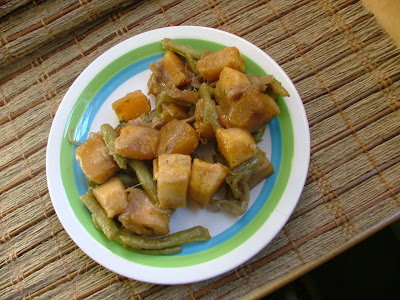 The definitive holiday cookie is Gingerbread Men.
The definitive holiday cookie is Gingerbread Men.Here are my criteria for reaching this decision.
The Definitive Christmas Cookie:
1. Must be so special (and such a pain in the putootie to make) that they are only to be made once a year
2. However, they still MUST be made every December, and if they are not, their absence leaves one depressed and feeling quite Scrooge like.
3. Must be a Christmas culture icon
4. Must be delicious
5. Must be beautiful enough to give as an impressive gift
Let's review the criteria: #1 Gingerbread Men are one of the most labor-intensive confections I make. The large amount of molasses in the recipe makes the dough sticky and difficult to work with. This is nothing that pampering the dough in the refrigerator and rolling out between two sheets of heavily floured wax paper can't fix. Even though the dough can be frustrating, I make gingerbread every year because they're special. Christmas wouldn't be the same without them, and not many people are crazy enough to spend 5 hours on one batch of cookies. Now, on to #3, who hasn't seen the stores this year loaded with gingerbread motifs? They're on wrapping paper and tree ornaments. The even come in pre-baked kits which I'm sure taste like cardboard.

Gingerbread Men are also a personal tradition of mine. I never grew up with Gingerbread Men. So perhaps that's why I cling so stoutly to gingerbread--it's a tradition of my own making. I started it when Kent and I started dating (7 years ago) because he loved gingersnaps so much. So naturally I quested after the perfect richly spiced Gingerbread recipe I could find. There were many failures, mostly vapid versions lacking in the truly robust flavor Gingerbread should have. This version of the cookie meets criteria # 4 easily. The molasses gives the cookies a golden base note. The texture is also impressive: crunchy on the outside, with a slight chewy toothiness on the inside. There's also a secret ingredient...

The secret ingredient, which I am being incredible generous in sharing with you all, because well, it is that time of year, is fresh ground black pepper.
Yes, these cookies have black pepper. ONE HALF TEASPOON OF BLACK PEPPER. The pepper makes them warm and spicy and manages to heighten and brighten the other typical Christmasy spices like ginger, cinnamon, and clove. It's sort of like how a shot of Peppermint Schnapps heightens and brightens a cup of cocoa. And that said, these cookies might be best kept away from the kiddies. The original recipe even has a note warning its potential bakers that using the whole teaspoon of black pepper may scare off the kiddies. But, trust me, spicing up your gingerbread with a spectacular zing and kick is worth it. This is not nursery food.
And finally, #5. I use royal icing made with meringue powder to ice the gingerbread men. And, I simply find a gingerbread man seems naked until he's wearing a good amount of icing rick-rack. Royal icing is very forgivable, easy to work with, and it dries rock hard, so this icing job will go the distance...even if you're shipping a batch of these babies to antsy relatives thousands of miles away.
Black Peppered Gingerbread Men
1 cup unsalted butter
1 cup dark brown sugar, packed
2 eggs
1 cup molasses
6 cups sifted all-purpose flour
1 t. baking soda
1/2 t. baking powder
4 t. ground ginger
4 heaping t. ground cinnamon
1 1/2 t. ground cloves
1/2 t. fresh ground pepper
1 1/2 t. salt
red hots and raisins for decoration
With electric mixer, cream together butter and sugar. Beat in eggs and molasses. In a separate bowl, sift together flour, soda, baking powder, spices, and salt. Stir flour mixture into butter mixture. Divide dough into thirds, and wrap in plastic. Chill for at least one hour or up to 12 hours.
To Bake: Preheat oven to 350 degrees. Roll dough to about 1/8 of an inch thick between two floured pieces of wax paper. Keeping reserved dough in the fridge. Cut into shapes with cookie cutters.
Interesting aside..."The first gingerbread man is credited to the court of Queen Elizabeth I, who favored important visitors with charming gingerbread likenesses of themselves." Also, in Victorian England, "Tinsmiths fashioned cookie cutters into all imaginable forms, and every woman wanted one shape that was different from anybody else's. Most of the cookies that hung on nineteenth-century Christmas trees were at least half an inch thick and cut into animal shapes or gingerbread men..."
---"Gingerbread," Karen S. Edwards & Sharon Antle, Americana [magazine], December 1988 (p. 49+)
Okay, so transfer your cutout cookies to an ungreased cookie sheet. (I use parchment paper for easy cleanup.) If desired, decorate with raisins and red hot candies. Bake for 8 to 10 minutes, until crisp, but not dark. Allow to cool on the cookie sheet for a minute after baking, then remove to wire racks to cook completely.
Royal Icing
2 cups powdered sugar
1 1/2 T. meringue powder (found in stores that carry quality cake decorating supplies.)
1/2 t. vanilla extract or lemon extract
1/4 cup warm water, or more to correct consistency
Mix sugar and meringue powder. Add the water gradually and the extract. Beat at low to medium speed until desired consistency is reached. You want a firm, but easily squeezable frosting for piping on gingerbread smiles. If you accidentally add too much water you can correct by adding slightly more powdered sugar. Use immediately, or store in an air tight container, as royal icing dries hard when exposed to air.










































